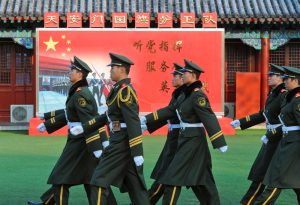The Ukraine Crisis has caused a renewed interest in the concept known as hybrid warfare (HW). There has been much speculation around hybrid warfare, and the concept has so far been notoriously hard to define. The description that seems to be most commonly accepted is that HW is a type of warfare which entails the use of a combination of different types of warfare by an adversary. This primarily entails employing a mixture of conventional and irregular troops in order for a specific actor to achieve its political goals. Furthermore, it also includes the widespread use of intelligence, propaganda and diplomatic means in order to persuade the adversary to surrender. The goal of an actor employing hybrid warfare is not merely the control of a piece of territory, nor the destruction of an opponent’s military force. According to Col. John J. McCuen:
Hybrid conflicts therefore are full spectrum wars with both physical and conceptual dimensions: the former, a struggle against an armed enemy and the latter, a wider struggle for control and support of the combat zone’s indigenous population, the support of the home fronts of the intervening nations, and the support of the international community… To secure and stabilize the indigenous population, the intervening forces must immediately rebuild or restore security, essential services, local government, self-defense forces and essential elements of the economy.
This paradigm was to a large degree followed by Russia in its highly successful operation in Crimea, and to a lesser degree in the Donbass. (Unofficially, this strategy has been nicknamed the Gerasimov-doctrine, after the retired Russian General Valeri Gerasimov who developed some of its key components.) Ukraine might have caused a recent renewal of interest in the relevance of hybrid warfare, but its basic, underlying thinking isn’t new. Actors as diverse as the Mongols, American Revolutionaries, and the Vietminh all employed strategies and tactics which we today characterize as hybrid warfare. (For a great introduction to the two latter actor’s uses of hybrid warfare, Max Boot’s Invisible Armies is a great place to start.)
For China, the rising power on everyone’s mind today in Asia, hybrid warfare has long been central to its strategic thought. In many ways, Sun Tzu’s Art of War expounds the core tenets of this concept. The Art of War’s focus on deception and intelligence, the mixed use of regular and irregular troops, and the emphasis on defeating the enemy’s will to fight would all seem familiar to someone studying Russia’s operations in Ukraine today. (Read: “Little Green Men”, RT.ru, and snap military exercises on Ukraine’s border, anyone?)
Throughout China’s history, elements of hybrid warfare have often been crucial components of its conflicts with its neighbors. Imperial Chinese rulers often dealt with their “barbarian” neighbors by following a recipe based on the “four methods approach”. Firstly, foreigners should be kept divided by “using barbarian to fight barbarians.” This would entail using barbarian mercenaries and strategic alliances to ensure division among China’s nomadic neighbors. The contemporary analogy would be “diplomatic warfare”; neutralizing unfriendly states through public diplomacy, support for local insurgencies and pressure in international organizations. Secondly, if this failed, bribes and tribute would be presented to foreign leaders in order to dissuade them from attacking China. The current equivalent would be the granting of lucrative trade and aid deals — a sort of economic warfare combined with a “soft power” approach. Thirdly, China would build fortifications in order to deter outside attack. Finally, if all else failed, military expeditions would be deployed.
The basics of this approach survived the fall of the Qing Dynasty. Perhaps the most famous practitioner of hybrid warfare is the Chinese Communist Party. Although the CCP and Mao Zedong are most famous for successfully using a combination of conventional and irregular troops to defeat the Nationalists under Chiang Kai-shek, the CCP’s real secret weapon was their mastery of propaganda, diplomacy, and information warfare. As Russia’s annexation of Crimea shows, these are some of the most effective tools in a HW-practitioner’s arsenal, often more effective than conventional military superiority. By being persuading the United States of the CCP’s legitimacy among the Chinese people as well as its detachment from the Soviet Union, Mao was able to eventually defeat Chiang and exercise control over the mainland.
The CCP today has not forgotten China’s long tradition of hybrid warfare. The current pacification policies in Xinjiang and Tibet employ many policies which are familiar to both students of Sun Tzu and Gerasimov. The government’s propaganda, information, and cyberwar campaigns, coupled with the use of irregular, local troops (i.e. the Xinjiang Production and Construction Corps) and, as a last resort, conventional police and military units, represent a form of HW with roots going back 2,500 years.
If history is any indication, hybrid warfare with Chinese characteristics is here to stay.

































